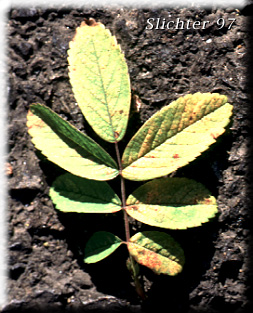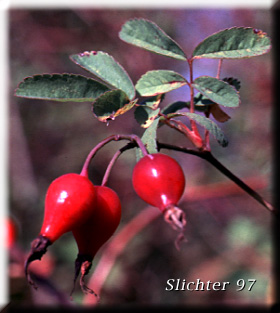 Characteristics:
Characteristics:
The clustered wild rose is a woody shrub to 2.5 meters in height. The stems are usually dark red or occasionally green, and the intertwine. The stems may be bare or if present, the prickles are straight, stout, and borne in pairs at the base of the stipules or petioles.
The leaves have 5-7 pinnately compound leaflets. The leaves are about 1.5 to 4 cm long. The leaflets are ovate and with toothed margins as seen above and at right.
The pink flowers are small and 5-petaled and found in clusters. The individual petals are about 1.5 cm long so the width of the whole flower ranges from 4-5 cm..
The fruits are egg-shaped rose hips, reddish purple in color, and about 1.2 cm long (essentially similar to miniature apples). The sepals remain attached to the base of the hip, and the backs of the sepals are usually coarsely glandular.
1. Dried flower petals for scents, potpourri.
2. Rose hips are high in vitamin C, may be made into jam, tea, and used as flavoring.
3. Clustered wild rose may be used as a hedgerow or as an ornamental.
4. Native Americans mashed the leaves together and made a poultice for application to sore eyes, abscesses, and bee stings.
5. The fruits are an important food source by various herbivores and upland game birds. The leaves and twigs are eaten by numerous browsers, and rose thickets provide excellent nesting and escape habitat for songbirds.
The clustered wild rose is found in thickets (groups) on moist swampy ground. It is often found in ditches along roads as well as along streams.
The clustered wild rose may be found from southern British Columbia south to the west of the Cascade summit to northern California.
In the Columbia River Gorge it may be found between the elevations of 100'-1800' from the western entrance to the gorge to as far east as the mouth of the Klickitat River.
